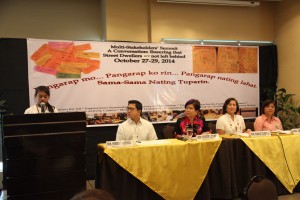
“Ang kalsada ay hindi ligtas para sa bata. Pagtulungan nating mailipat sila sa ligtas na lugar (The streets are not safe for children. Let us work together to bring them to safe places),” DSWD Secretary Corazon Juliano-Soliman said during yesterday’s closing ceremony of the three-day Multi-Stakeholders Summit on Street Dwellers in Mandaluyong City.
According to Sec. Soliman, the summit, dubbed as “A Conversation: Ensuring that street dwellers are not left behind” is a good opportunity to address the varied concerns of street dwellers with the different non-government agencies (NGA), non-government organizations (NGOs), corporate foundations, business sector, and the local government units (LGU) working together to come up with concrete and appropriate programs and sustainable solutions.
“There are ways and means to establish additional facilities for street children. Inter-agency efforts are being done to rescue and provide safe havens for them. The bottom line is we must not let them stay on the streets,” Sec. Soliman emphasized.
To address the needs of street dwellers, DSWD is working closely with the Department of Education (DepED) in implementing the Alternative Learning System (ALS); Metro Manila Development Authority (MMDA) and LGUs in conducting rescue operations; Departments of Environment and Natural Resources (DENR) and Agriculture (DA) in ensuring they have lands to till should they avail of the ‘Balik Probinsya” program; Department of Tourism (DOT) in providing jobs in parks; and, Technical Education and Skills Development Authority (TESDA) in providing skills training.
DSWD is currently implementing the Modified Conditional Cash Transfer for Homeless Street Families.
To date, some 2,311 street families are registered in the program. Of this number, 1,348 families availed of the house rental subsidy for six months.
Based on the rapid assessment done by DSWD in 2010 and 2013, there was a decrease in the number of children living in the streets, from 3,072 in 2010 down to 1,270 in 2013. However, there was an increase in the number of street families from 657 in 2010 to 1,568 in 2013, while the number of individual adults living in the streets also went down from 2,014 in 2010 to 653 in 2013.
As of April 2013, there are 12,042 street dwellers.
Foremost reasons why they are on the streets include marital, family, and work-related problems. Others used to have houses but were demolished, and some lack of financial resources to rent or own homes. There are also those who were victims of disasters.
Change of mindset
Meanwhile, Quezon City Mayor Herbert Bautista said, “The mindset must be changed, including in government. Opportunities in the provinces must be elevated.”
Mayor Baustista also explained that the misconception that employment and other opportunities abound in Metro Manila must also be corrected.
“People from the provinces flock to the cities to seek greener pasture, but there are also opportunities in the rural areas. The local governments are there, possibilities have to be explored. With the intervention of DSWD and stakeholders, street dwellers learned that programs are available,” Mayor Bautista added.
Clarifying the issue that street children are forced to go with authorities during rescue operations, MMDA Undersecretary Corazon Jimenez said, “We talk to them, they are not forced. We bathe them and bring them to DSWD facilities.”
The three-day Summit yielded three areas of collaboration for the different sectors, which are education, employment, and advocacy and legislation.
The stakeholders were united in saying that if street dwellers are educated, they can have gainful employment, while continuous advocacy and appropriate legislative measures are needed to ensure that they do not return to the streets. ###


